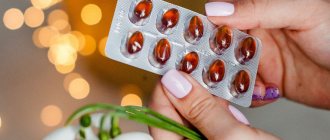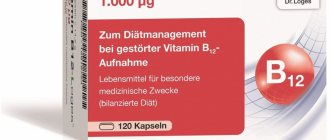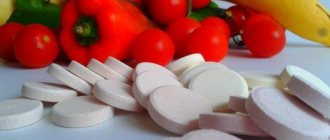Initial appointment with a THERAPIST with 25 years of experience
ONLY 1800 rubles!
(more about prices below)
Vitamin F is a vitamin-like group of three polyunsaturated fatty acids: arachidonic, linoleic and linolenic. It was opened in 1928. Its name comes from the English word “fat”, which means “fat”. Vitamin F cannot be synthesized in the human body, so it is important to obtain it daily from external sources. According to statistics, a deficiency in the consumption of this vitamin is observed in about 80% of the adult population of St. Petersburg.
If you have such an opportunity, it is best to take vitamins by injection for medicinal purposes, since their bioavailability or absorption by the body is higher when administered by injection.
Vitamin F deficiency
The recommended daily dose of vitamin F is about 1-2 g. With a lack of vitamin F, the following occurs:
- fatigue;
- dry skin, eczema;
- frequent colds;
- menstrual irregularities;
- male infertility;
- swelling on the face;
- brittle nails;
- decreased concentration.
If you feel a lack of vitamin F, I recommend including the following dishes in your menu:
- salad of fresh vegetables and mussels;
- fried eggs with avocado;
- scallop stewed in cream.
| Service | Price | Promotion Price |
| Beauty-cocktail (11 blood tests, 10 Beauty-drips, appointment with a therapist) | 39,000 rub. | RUB 35,555 |
| Immuno Protect program (2 blood tests, Immuno Protect droppers, appointment with a therapist) | RUR 7,777 5 sessions | RUB 11,111 10 sessions |
| Anti-age program (blood test for vitamin B 1, B5, B6, B12, C, E, K, D, IVs with an individual vitamin complex, appointment with a therapist) | RUB 21,111 5 sessions | RUB 25,555 10 sessions |
| Anti-stress program (7 blood and urine tests, 10 Anti-stress droppers, appointment with a therapist) | 35,000 rub. | RUB 29,999 |
| Detox program for comprehensive body cleansing (10 droppers, 10 autohemotherapy, tests, appointment with a therapist) | 17,000 rub. | 13,500 rub. |
| Recovery course of IVs after COVID-19 (Coronavirus) | 4050 rub. 5 sessions | 8100 rub. 10 sessions |
| Vitamin therapy (course of 10 intramuscular injections, consultation with a therapist) | 4,000 rub. | 3,000 rub. |
| Intravenous drip administration of drugs (without drugs, 1 bottle) | 800 rub. 1 session | RUB 3,375 5 sessions 6,750 rub. 10 sessions |
| Intravenous drip administration of medications (with existing clinic medications, 1 bottle) | 950 rub. 1 session | 4,050 rub. 5 sessions 8,100 rub. 10 sessions |
| Intravenous drip administration of drugs (without drugs, 2 bottles) | 950 rub. 1 session | 4,050 rub. 5 sessions 8,100 rub. 10 sessions |
| Intravenous drip administration of medications (with existing clinic medications, 2 bottles) | 1100 rub. 1 session | 4,700 rub. 5 sessions 9,400 rub. 10 sessions |
| Intravenous administration of drugs (course) | 450 rub. 1 session | RUB 2,140 5 sessions 4,050 rub. 10 sessions |
| Intravenous administration of immunoglobulin (without the cost of the drug) | 3500 rub. | |
| Dropper of Human Immunoglobulin - Imbioglobulin 50 mg/ml, 20 ml (price includes the cost of the drug) | 7500 rub. | |
| Dropper of Human Immunoglobulin - Imbioglobulin 50 mg/ml, 50 ml (price includes the cost of the drug) | 10500 rub. | |
| Dropper of Human Immunoglobulin - Octagam 50 mg/ 50 ml (price includes the cost of the drug) | 14,000 rub. | |
| Dropper of Human Immunoglobulin - Octagam 50 mg/100 ml (price includes the cost of the drug) | 29,000 rub. | |
| Dropper of Human Immunoglobulin - Octagam 50 mg/200 ml (price includes the cost of the drug) | 49,000 rub. | |
| Dropper of Human Immunoglobulin - Intratect 50 mg/ 50 ml (price includes the cost of the drug) | 14,000 rub. | |
| Dropper of Human Immunoglobulin - Intratect 50 mg/100 ml (price includes the cost of the drug) | 29,000 rub. | |
| Dropper of Human Immunoglobulin - Intratect 50 mg/200 ml (price includes the cost of the drug) | 49,000 rub. | |
| Appointment (examination, consultation) with a general practitioner to prescribe IVs | 1,800 rub. primary | 1,500 rub. repeated |
| Autohemotherapy | 550 rub. 1 session | 2,500 rub. 5 sessions 5,000 rub. 10 sessions |
| Plasma therapy of the spine and joints | 4500 rub. 1 session | 10,500 rub. 3 sessions 17,500 rub. 10 sessions |
| Subcutaneous-intradermal administration of drugs (course) | 250 rub. 1 session | RUB 1,180 5 sessions 2,250 rub. 10 sessions |
| Intramuscular administration of drugs (course) | 300 rub. 1 session | RUB 1,575 5 sessions 2,700 rub. 10 sessions |
Author: Telegina Natalya Dmitrievna
Therapist with 25 years of experience
>
Fat-soluble vitamins - vitamins A, D, E, K, which are vital micronutrients necessary for normal cell function, metabolism of proteins, fats, carbohydrates and electrolytes, the functioning of various enzyme systems of the body, redox processes, blood clotting, growth and development . Vitamin deficiency has a serious negative impact on human health and the functions of many organs, and an excess of some vitamins has a toxic effect.
Synonyms Russian
Fat-soluble vitamins (retinol, calciferol, tocopherol, 2-methyl-1,4-naphthoquinone)
English synonyms
Fat soluble vitamins
Research method
High performance liquid chromatography-mass spectrometry (HPLC-MS)
Units
μg/ml (micrograms per milliliter), ng/ml (nanograms per milliliter).
What biomaterial can be used for research?
Venous blood
How to properly prepare for research?
- Do not eat for 8 hours before the test; you can drink clean still water.
- Do not smoke for 30 minutes before the test.
General information about the study
Vitamins are essential organic substances needed by the body in small quantities. They are part of coenzymes involved in redox reactions, tissue respiration, synthesis of proteins, fats and carbohydrates, formation of hormones, growth, maturation and division of cells, tissue formation, protection against infections. According to their biochemical properties, vitamins are divided into water-soluble (B vitamins, vitamin C) and fat-soluble (vitamins A, D, E, K).
The human body is not able to synthesize vitamins on its own, but some can accumulate in the liver (vitamins A, D, E). For their absorption from the gastrointestinal tract, the presence of fats is necessary. Vitamins are found in foods of plant and animal origin. During heat treatment and exposure to light, the vitamin content in products decreases. They are also destroyed under the influence of alcohol, nicotine, and caffeine. Fat-soluble vitamins can accumulate in the body and cause toxic effects in high doses.
Vitamin deficiency occurs with an unbalanced and irrational diet, diseases of the gastrointestinal tract, which are accompanied by impaired absorption of nutrients, bile secretion (for fat-soluble vitamins), or with increased consumption of vitamins in metabolism (for example, during pregnancy, lactation).
Vitamin A is necessary for normal vision, growth and differentiation of epithelial tissue, bone growth, fetal development, and the functioning of the immune and reproductive systems. In the body, retinol is synthesized from the fat-soluble provitamin beta-carotene. Sources of beta-carotene include pumpkin, carrots, sweet potatoes, green onions, sorrel, spinach, lettuce, lettuce, lettuce, kale, tomatoes, red peppers, broccoli, grapefruits, plums, peaches, melons, apricots, persimmons, gooseberries, blueberries, black currant, retinol - fish oil, liver, butter, yolk, milk. The daily requirement for retinol for children, depending on age, is 400-900 mcg, for adults – 900 mcg. The absorption of vitamin A from the intestines decreases with insufficient amounts of vitamin E and zinc. Signs of hypovitaminosis A include abnormal development of bones, bones and teeth, a feeling of dryness and irritation in the eyes, hair loss, decreased appetite, skin rashes, recurrent infections and impaired night vision (“night blindness”). Unlike vitamin A, beta-carotene in high doses does not have toxic properties and does not cause hypervitaminosis. Excessive intake of vitamin A can lead to dizziness, increased intracranial pressure, cheilitis, alopecia, and liver fibrosis. In high doses, retinol has a teratogenic effect.
Vitamin D (calcitriol) is a precursor of the hormone responsible for calcium metabolism and the regulation of bone tissue formation. The main sources of vitamin D precursors are fatty fish, fish oil, butter, cheese and other dairy products, and yolk. Under the influence of ultraviolet radiation in the skin, they are converted into active forms of the hormone, which prevent the development of rickets in children and osteoporosis and osteomalacia in adults. Vitamin D deficiency is associated with cardiovascular, cancer and autoimmune diseases. Considering the possibility of an overdose of cholecalciferol, when taken prophylactically, the dose of the drug should not exceed 10-15 mcg/day. Long-term excess vitamin D can cause tissue calcification and kidney damage. When consuming cholecalciferol in high doses, headaches and gastrointestinal disorders may occur.
Vitamin E is an important antioxidant, antihypoxant, immunomodulator and coenzyme in the processes of collagen formation, takes part in the regulation of lipid balance, gene expression, and neurological functions. With a balanced diet, the body receives a sufficient amount of vitamin from vegetable oils, nuts, green leafy vegetables, cereals, yolk, liver, and milk. Due to vitamin E deficiency, peripheral neuropathy, myopathy, and infertility occur. Profound vitamin deficiency is manifested by hemolytic anemia. Increased levels of vitamin E in the body reduce platelet aggregation and blood clot formation.
Vitamin K is necessary for the synthesis of blood clotting factors. Vitamin K is synthesized in small amounts by the colon microbiota. Food sources include green leafy vegetables, various types of cabbage, cereals, bran, meat, dairy products, eggs, fruits, olive oil. The recommended daily intake of vitamin K is 120 mcg/day. With its deficiency, bleeding occurs, and with its excess, hemolytic anemia and hyperbilirubinemia in children occur.
For a number of different reasons, a deficiency of individual vitamins can develop (for example, scurvy, ariboflavinosis, pellagra, beriberi, rickets), but multivitamin deficiency is more common. Digestive disorders, pathologies of the pancreas, liver and small intestine lead to a decrease in the absorption of vitamins and provitamins from food. Studying the level of fat-soluble vitamins in the blood makes it possible to assess the body’s supply with these essential substances, differentiate various types of hypo- and hypervitaminosis, justify measures to correct vitamin deficiency and select an adequate diet and therapeutic therapy.
What is the research used for?
- Diagnosis of fat-soluble vitamin deficiency;
- differential diagnosis of hypo- and hypervitaminosis and clinically similar conditions;
- nutritional balance assessment;
- diagnosis of hypervitaminosis.
When is the study scheduled?
- In case of malabsorption syndrome due to diseases of the gastrointestinal tract (celiac disease, cystic fibrosis, inflammatory bowel diseases, pathology of the pancreas, conditions after resection of the stomach and/or small intestine, obstruction of the biliary tract);
- with clinical signs of deficiency of fat-soluble vitamins (dermatitis, dry mucous membranes, prolonged diarrhea, neurological disorders, anemia, reproductive disorders);
- when examining patients with malnutrition, alcoholism, or those on parenteral nutrition;
- with steatorrhea (increased fat content in the stool due to their insufficient absorption in the intestines).
What do the results mean?
Reference values
| Vitamin A | 0.30 - 0.80 µg/ml |
| Vitamin D | 3.00 – 49.60 ng/ml |
| Vitamin E | 5.00 - 18.00 µg/ml |
| Vitamin K | 0.10 - 2.20 ng/ml |
Reasons for the increase:
- Oral or parenteral administration of vitamin preparations.
Reasons for the downgrade:
- Insufficient intake of vitamins into the body:
- inadequate and unbalanced nutrition (including parenteral);
- improper storage and preparation of products;
- gastrointestinal diseases accompanied by malabsorption syndrome (pathology of the liver and pancreas, celiac disease, cystic fibrosis, persistent diarrhea, Crohn's disease);
- anorexia;
- condition after surgical treatment of gastrointestinal diseases (for example, gastrectomy, resection of the small intestine, anastomosis).
- prolonged fever;
- chronic infections;
- diseases of the hepatobiliary region (acute and chronic hepatitis, cirrhosis of the liver);
- hyperthyroidism;
- neoplasms;
- alcoholism;
- poisoning by radionuclides, toxic substances and compounds;
- pregnancy (especially against the background of nicotine and drug addiction, multiple pregnancy);
- lactation period.
What can influence the result?
- Taking vitamins and vitamin-containing preparations before taking the test distorts the result of the study.
- Vitamin A. The level of vitamin A in the blood decreases when taking fatty acid sequestrants (cholestyramine), weight loss drugs (orlistat), proton pump inhibitors, mineral oil, drinking alcohol, and nicotine addiction.
- Vitamin D. Blood levels are reduced by phenytoin, phenobarbital, rifampicin, oral anticoagulants, and isoniazid.
- Vitamin E. Decreases with the use of oral contraceptives and low-fat diets.
- Vitamin K. Broad-spectrum antibiotics, warfarin, inhibit the activity and level in the blood.
How does it affect the skin?
The benefits of vitamin F have been clearly proven. If you pick up a tube of skin cream, this vitamin is sure to be present in the composition, because thanks to it our skin glows with health and shines in the sun. When working together with other vitamins, a powerful antioxidant effect occurs in our body.
For any damage to the skin, it has an immediate effect on the affected area. For various skin diseases, be it eczema or dermatitis, it leads to a speedy recovery. One has only to apply the drug to the skin, saturated with this element.
When it comes to cosmetics, vitamin F always comes first. It retains moisture on the skin, making it elastic and pleasant to the touch, which prolongs the youth of your skin.
Reference! The drug can be purchased at the pharmacy in the form of tablets or ampoules.
How to choose cosmetics with vitamin F
Today, many brands produce cosmetic products containing this component. This element is used in products that help cope with the following problems:
- acne;
- increased dryness of the skin, accompanied by peeling of the epidermis;
- skin aging;
- sunburn;
- severe hair loss;
- seborrhea, etc.
Below I present to your attention six cosmetic products containing vitamin F. If you already use these products, write a review about them in the comments. Did the remedy work for you, what did it help you get rid of?
Cream F99
This creamy product is sold at the pharmacy. Its main purpose is to eliminate skin problems, as well as care for sensitive epidermis. This is a universal product that can be used by both adults and children.
This cream is available in two types: bold and semi-bold. The first one has a greasy consistency. The rich cream eliminates skin irritations. In addition, this product has an exfoliating effect. And the semi-oily cream with vitamin F is created for sensitive skin types. In addition, it perfectly tightens weeping eczema.
Their prices are low. And judging by the reviews, they earn their money







